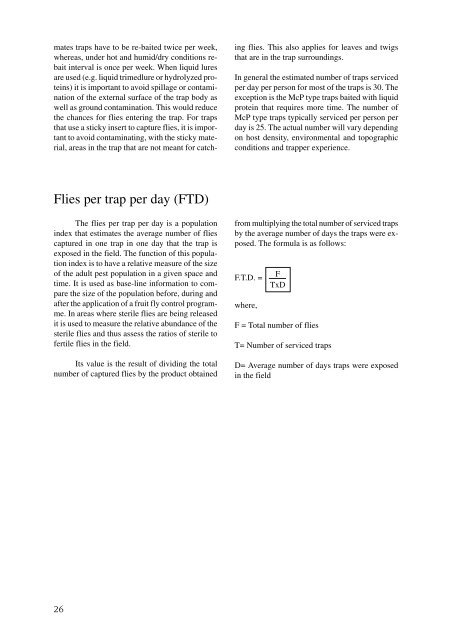Fruit fly trapping guide - IAEA Publications - International Atomic ...
Fruit fly trapping guide - IAEA Publications - International Atomic ...
Fruit fly trapping guide - IAEA Publications - International Atomic ...
You also want an ePaper? Increase the reach of your titles
YUMPU automatically turns print PDFs into web optimized ePapers that Google loves.
mates traps have to be re-baited twice per week,<br />
whereas, under hot and humid/dry conditions rebait<br />
interval is once per week. When liquid lures<br />
are used (e.g. liquid trimedlure or hydrolyzed proteins)<br />
it is important to avoid spillage or contamination<br />
of the external surface of the trap body as<br />
well as ground contamination. This would reduce<br />
the chances for flies entering the trap. For traps<br />
that use a sticky insert to capture flies, it is important<br />
to avoid contaminating, with the sticky material,<br />
areas in the trap that are not meant for catching<br />
flies. This also applies for leaves and twigs<br />
that are in the trap surroundings.<br />
In general the estimated number of traps serviced<br />
per day per person for most of the traps is 30. The<br />
exception is the McP type traps baited with liquid<br />
protein that requires more time. The number of<br />
McP type traps typically serviced per person per<br />
day is 25. The actual number will vary depending<br />
on host density, environmental and topographic<br />
conditions and trapper experience.<br />
Flies per trap per day (FTD)<br />
The flies per trap per day is a population<br />
index that estimates the average number of flies<br />
captured in one trap in one day that the trap is<br />
exposed in the field. The function of this population<br />
index is to have a relative measure of the size<br />
of the adult pest population in a given space and<br />
time. It is used as base-line information to compare<br />
the size of the population before, during and<br />
after the application of a fruit <strong>fly</strong> control programme.<br />
In areas where sterile flies are being released<br />
it is used to measure the relative abundance of the<br />
sterile flies and thus assess the ratios of sterile to<br />
fertile flies in the field.<br />
Its value is the result of dividing the total<br />
number of captured flies by the product obtained<br />
from multiplying the total number of serviced traps<br />
by the average number of days the traps were exposed.<br />
The formula is as follows:<br />
F.T.D. =<br />
where,<br />
F<br />
TxD<br />
F = Total number of flies<br />
T= Number of serviced traps<br />
D= Average number of days traps were exposed<br />
in the field<br />
26













